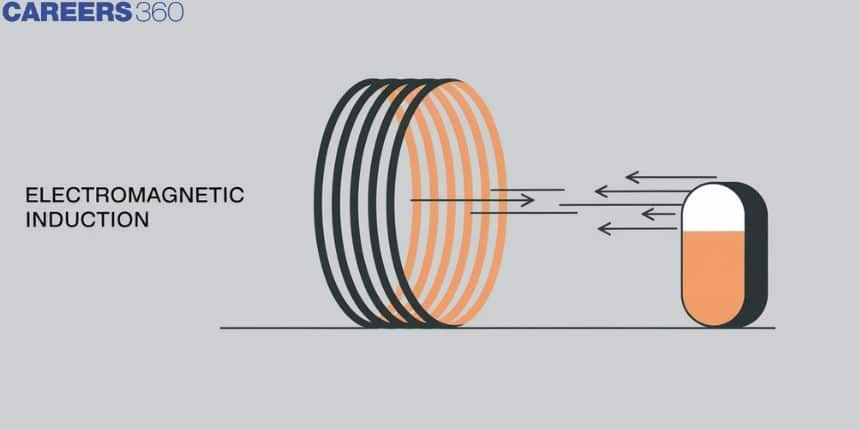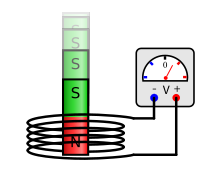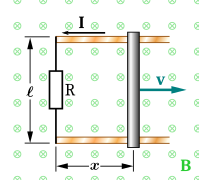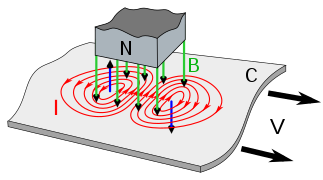Electromagnetic Induction - Definition, Formula, Examples, FAQs
Electromagnetic induction is a very important topic in physics that explains how electricity can be produced using magnetism. When the magnetic field linked with a conductor or coil changes, an electric current is produced in it. This simple idea was discovered by Michael Faraday and forms the basic principle behind many electrical devices we use every day. Electromagnetic induction helps us understand the working of electric generators, transformers, motors, and induction cooktops. It also explains how electrical energy can be generated without using batteries. In this article, electromagnetic induction is explained in very simple and easy language for students, along with its definition, examples, formulas, laws, and applications, making it helpful for school exams and competitive exam preparation.
This Story also Contains
- What do you mean by Electromagnetic Induction?
- Electromagnetic induction formula
- Electromagnetic Induction Example
- Application of Electromagnetic Induction

What do you mean by Electromagnetic Induction?
Electromagnetic induction is the phenomenon in which an electric current (or emf) is produced in a conductor when the magnetic field linked with it changes.
In simple words, when a magnet is moved near a coil or a coil is moved in a magnetic field, an electric current is induced in the coil.
This phenomenon was discovered by Michael Faraday.
Definition
Electromagnetic induction is the process of generating an electric current in a conductor by changing the magnetic flux linked with it.
Examples
- Current induced when a magnet is moved toward or away from a coil
- Electric generators
- Transformers
NCERT Physics Notes:
Michael Faraday built up a conducting wire as shown below, which was connected to a device that measured the voltage across the circuit. The voltage detector monitors the voltage in the circuit when a bar magnet is moved through the coiling.

Electrostatic induction
Electrostatic induction is a change in the distribution of electric induction charge on a material caused by the impact of adjacent charged particles. When an object is placed in an electric induction field, electrostatic induction occurs.
Electromagnetic induction formula
The induced voltage can be calculated using the following formula:
$\mathrm{e}=\mathrm{N}(\mathrm{d} \Phi / \mathrm{dt})$
- The induced voltage is denoted by the letter e. (in volts)
- The coil's number of turns is N.
- t is the time, and Φ is the magnetic flux – the amount of magnetic field at a surface (in Webbers) (in seconds)
The significance of this finding is that it demonstrates a method of producing electric inductional energy in a circuit without the use of batteries. Electromagnetic induction is used in everyday machinery such as motors, generators, and transformers.
Also read -
- NCERT Solutions for Class 11 Physics
- NCERT Solutions for Class 12 Physics
- NCERT Solutions for All Subjects
Faraday’s law of electromagnetic induction
First law: When a conductor is put in a changing magnetic field, an induced EMF is produced, and if the conductor is closed, an induced current flows through it.
The magnitude of the induced EMF is equal to the rate of change of flux connections, according to the second law.
Faraday's law of electromagnetic induction, based on his experiments, states that the amount of voltage induced in a coil is proportionate to the number of turns and the changing magnetic field of the coil.

As a result, the induced voltage is now:
e = N (dΦ/dt)
where,
- The induced voltage is denoted by the letter e.
- The coil's number of turns is N.
- φ is a measure of magnetic flux
- t is time
|
Related Topics, |
Lenz’s law of electromagnetic induction
When an emf induces according to Faraday's law, the polarity (direction) of that induced emf opposes the cause of its generation, according to the Lenz law of electromagnetic induction.
Lenz's law states that,
$\mathrm{E}=-\mathrm{N}(\mathrm{d} \Phi / \mathrm{dt})($ volts $)$
Eddy current
The current swirls in such a way that it creates a magnetic field that opposes the change, according to the Lenz law of electromagnetic induction. Eddy currents waste energy because they have a tendency to oppose one another. Eddy currents convert more usable kinds of energy like kinetic energy into heat, which isn't always useful. Although the loss of usable energy is undesirable in many electromagnetic induction applications, it does have some beneficial electromagnetic induction applications.

Electromagnetic Induction Example
- some trains' brakes. The brakes expose the metal wheels to a magnetic field during braking, which causes eddy currents to form in the wheels. The wheels are slowed by the magnetic interaction between the applied field and the eddy currents. The impact is larger the quicker the wheels spin, thus as the train slows down, the braking force decreases, resulting in a smooth stop.
- Few galvanometers with a fixed core made of nonmagnetic metallic material exist. When the coil oscillates, the core's eddy currents oppose the motion and bring the coil to a stop.
- The melting of metals in an induction furnace can be used to make alloys. The eddy currents in the metals generate a high enough temperature to melt it.
EMF (electro-motive force)
The energy per unit electric induction charge given by an energy source, such as an electric induction generator or a battery, is known as electromotive force, abbreviated E or emf. The property of any energy source capable of pushing electric induction charge around a circuit is called electromotive force.
Also read :
Application of Electromagnetic Induction
We now have Faraday's law, which states that the amount of voltage induced in a coil is proportional to the number of turns in the coil and the rate at which the magnetic field changes.
- The principle of electromagnetic induction governs the operation of an AC generator.
- The principle of electromagnetic induction governs the operation of electric inductional transformers.
- The electromagnetic induction is used to power the magnetic flow meter.
Also, check-
Frequently Asked Questions (FAQs)
A voltage is formed by passing a wire through a magnetic field, which is known as electromagnetic induction. Physicist Michael Faraday discovered electromagnetic coil induction.
Three things influence the size of the voltage:
The magnitude of the magnetic field.
The conductor's active length.
The speed with which the conductor moves through the field.
Magnetic induction image outcome
When a charged particle travels, it is subjected to a force known as the magnetic field, magnetic induction, or magnetic flux intensity. The letter 'B' stands for it. The tesla is the SI unit for magnetic induction (B). One weber per metre square equals one tesla.
Electric induction generators and electric induction transformers are two significant devices that rely on electromagnetic induction. Both devices are essential for producing and managing the electric induction current we rely on every day. Electromagnetic induction is used in electric induction generators to convert kinetic energy to electric inductional energy.
The amount of voltage induced magnetism is proportional to the rate of change in the magnetic field flux and the number of turns of wire exposed to the flux change (if coiled).
The number of turns in a coil determines the induced e.m.f.
The rate of movement of the conductor through the magnetic field.
The conductor's overall length.
The pace at which the magnetic lines of force are severed by the conductor.